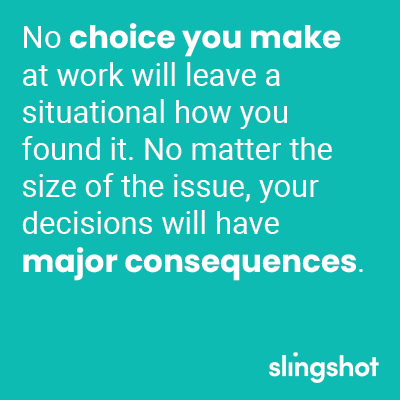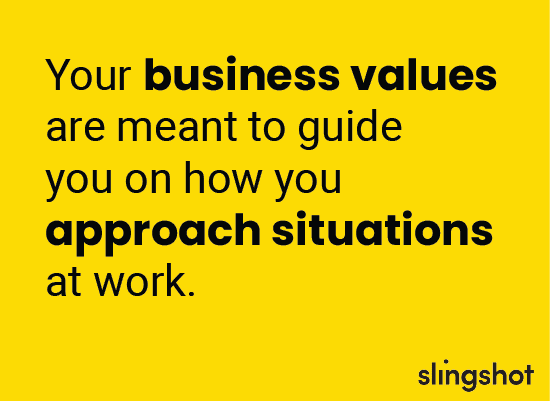When was the last time you had to make a decision at work? The answer: every day. While most are small choices, others can make or break your business.
If there’s a massive change coming to your industry, you’ll have to make a choice on if you’ll ride the wave or stay behind. But we’re not here to say if you should make the change or not
Today, we want to help equip you with the tools to make the right decision: responding to change instead of reacting to it. Check out why making sure you respond is vital, and how to successfully do just that.
When was the last time you had to make a decision at work? The answer: every day. While most are small choices, others can make or break your business.
If there’s a massive change coming to your industry, you’ll have to make a choice on if you’ll ride the wave or stay behind. But we’re not here to say if you should make the change or not
Today, we want to help equip you with the tools to make the right decision: responding to change instead of reacting to it. Check out why making sure you respond is vital, and how to successfully do just that.
Summary
- You react when you quickly make a decision based on emotion. You respond when you think through your choices and use evidence as your guide.
- If you make a choice based on impulse, you could turn a small issue into a major problem with lost resources, partnerships, and clients.
- Before evaluating how to respond, you need to check if you should respond: review your company values and goals to make sure the pivot aligns with your vision.
- If a pivot does make sense, look into its severity and needed resources.
- Did the response not work? Don’t revert back to reacting; continue to respond by using your learnings to propel yourself forward.
What is Reacting? |
What is Responding? |
| When you’re reacting to a situation, you’re making a decision without thinking it through all the way. It’s usually made quickly and is based on emotion. | When you think through how you’ll react to a situation, that’s responding. You’re using evidence to come to a decision, and are focusing on results rather than fear. |
Why Responding (Instead of Reacting) Matters
Of course, we’d all like to say every decision we make is based on evidence, not emotions. But that’s simply not true: we can all think of a time in business when we acted on impulse.
If we all react instead of respond, then why does it matter, especially on ‘small’ issues? Think of it this way: No choice you make at work will leave a situational how you found it. Whether it’s something as small as an email exchange, or as big as creating a whole new arm of your business, your decisions can have major consequences.

Even the smallest industry change can spiral into a massive problem if you don’t think through your response. What could these problems be? Well, you could be…
- Wasting resources with a technology that doesn’t pan out
- Losing responsibility due to poor planning
- Missing out on business deals as a result of incorrect pivots
- Continuing reaction to try and fix the original issue (aka burying yourself deeper)
How to Respond Instead of React
The list above should send a shiver down your spine; you’re trying to make decisions that are best for the long run (and not the short run) after all.
It’s certainly more than just recognizing you have feelings tied to your business decisions. Think about the last time your company was deciding whether to pivot or not. Did you have strong feelings? Did you think y’all moved too fast or too slow? In the end, did the decision help or hurt?
If you see something on the horizon, you need to find the balance between moving quickly to reap the benefits but not jumping too quickly and regretting it. You don’t want to join the bandwagon, but you also don’t want to be on a sinking ship.
So how exactly do you make sure your business strategy is responsive instead of reactive? Don’t worry: a list is on the way!
Review Your Principles
Your company listed the company values in the company handbook for a (company) reason, right? One reason you write down your business values is to guide you on how you approach situations at work: from client interactions to major pivots and everything in between.

When it comes to deciding on whether you should move forward with a big change, ask if it fits with your values as a business. If the shift fits, then evaluate. And if not, use your resources to find a decision that does.
Is This a Code Red?
Once you’ve done an internal deep dive, you need to figure out how big of an issue this topic is. When actively trying to respond, the best place to start is to evaluate the impact of the problem based on what you already know.
Instead of speculating on all the possible outcomes, figure out just how serious the problem is, and create an action plan based on that. You should also set a time when you’ll evaluate the situation again to make sure you’re still on the right path.
TLDR: quickly decide if you need to make a decision.
Context is Key
Not every business needs an opinion on every major issue in the world. The same goes for major changes in your industry; just because one competitor is changing doesn’t mean you have to.
Ask yourself: What’s the reason they’re pivoting? Is that reason one that my business should care about? Once you step back and look at the bigger picture, you may realize this problem isn’t even a problem.
Resource Reassessment
So you’ve evaluated this industry change based on value alignment, severity, and if it even makes sense for y’all to address. Now you need to figure out if you have the team to do what you need.
Before deciding how you’ll respond to industry changes, you need to make sure you can. You’ll want to evaluate it all: skill sets, vendor partnerships, and current systems. For example, let’s say there’s a new language you’re evaluating. You’ll want to make sure your team has the skills required, and that this new language doesn’t interfere with what you already have.
What if you don’t have the resources you need? Great question! The first step in making a responsive change is to see if you can either source it yourself or find a realistic alternative. Again, from our example above, you could bring in an outsourced team if no one on staff has experience in the new language.

Cheesy, but Think Outside the Box
If your industry is changing, maybe it’s time to change the way you think about the industry. A reaction would be something you’ve already tried; aka, what feels most comfortable. That’s what you’ve been doing so far, and it may be time to switch things up.
When responding, You’re trying to make a decision with as much relevant evidence as possible. Gathering ideas and perspectives you normally would avoid could be one way to see a fresh side of things. Use some unconventional thinking to see how else you could respond to change.
Fail Successfully
The biggest concern when thinking about massive change is the risk of failure. It all ties back to the reaction piece: we’re emotionally invested in the outcome. Failure means we did something wrong.
The important thing to remember here is that you want to fail successfully: meaning take what you learned from the failure and pivot again. A reaction to failure would be to go back to the old ways and never try again. A response to failure would be to use your learning to go in a different direction.
Conclusion
Making the right decisions in response to industry changes is crucial for the success of any business. By understanding the difference between reacting and responding, evaluating the severity of the issue, reassessing resources, and thinking outside the box, you can make informed decisions that align with your company’s values and goals.
Remember that failure is a natural part of the process, and the key is to fail successfully by learning from your mistakes and pivoting when necessary. With these tools and strategies, you can navigate industry changes with confidence and hopefully avoid those bandwagons and sinking ships.




